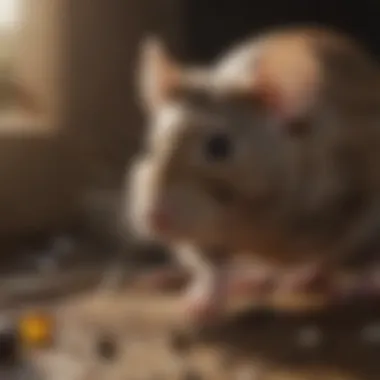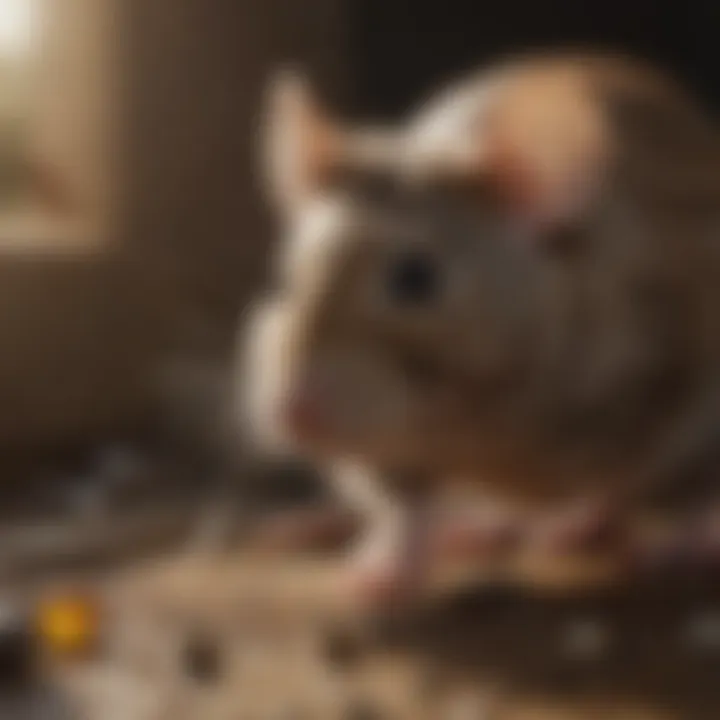Natural Strategies to Effectively Eliminate Mice


Intro
Mice are a common pest issue in many households. Understanding how to effectively deal with them can greatly improve the comfort and safety of your living space. This section will provide essential insights into recognizing the presence of mice and the natural methods available for their removal. A proactive approach starts with pest identification. Knowing the signs of an infestation is crucial for effective management. By following this guide, homeowners can learn to eliminate mice without the use of harmful chemicals.
Pest Identification
Identifying mice and their activity is the first step in addressing an infestation. Here are key aspects to know:
Detailed Descriptions of Common Pests
The house mouse, scientifically known as Mus musculus, is the most prevalent rodent in urban settings. They are small, typically measuring about 3 to 4 inches long, with a slender body, large ears, and a long tail. Their fur is usually gray or light brown. Other common species include the field mouse and the deer mouse, which have similar characteristics but may differ in habitat preferences.
Signs and Symptoms of Infestations
Several indicators can signal a mouse presence in your home:
- Droppings: Small, dark pellets are often found near food sources or nesting areas.
- Nesting Material: Mice use shredded paper, fabric, or plant materials for nesting.
- Gnaw Marks: Teeth marks on food packaging or furniture can hint at mice activity.
- Noises: Scratching sounds at night within walls or ceilings are telltale signs.
- Footprints: Track marks in dusty areas may reveal their often-hidden pathways.
Detecting and understanding these signs is foundational in implementing effective control methods.
Prevention Strategies
Once mice are identified, focus shifts to preventing their entry and nesting within your home:
Home Maintenance Tips for Pest Prevention
- Seal Entry Points: Inspect your home for gaps and holes, often around windows and doors, and seal them properly.
- Proper Food Storage: Keep all food sealed in airtight containers to eliminate food sources.
- Clutter Management: Reduce clutter in and around your home as it can provide hiding spots.
Natural Deterrents and Barriers
Utilizing natural deterrents can further protect your home:
- Peppermint Oil: Mice dislike strong scents. Soak cotton balls in peppermint oil and place them in areas prone to infestation.
- Vinegar Mixture: A mix of vinegar and essential oils can also deter mice if sprayed around entry points.
- Ultrasonic Repellents: Devices emitting high-frequency sounds can discourage mice from entering your space.
Implementing these strategies can create significant obstacles for mice, making your home less inviting to them.
Treatment Options
If prevention is not successful and mice have invaded, treatment options must be addressed:
Overview of Chemical vs. Natural Treatments
Chemical treatments often involve traps or poisons, which might pose risks to pets and children. Conversely, natural treatments tend to be safer and more environmentally friendly. Focusing on non-toxic methods is advisable.
Step-by-Step Guides for DIY Treatments
- Homemade Traps: Setting up simple traps using a bucket and some bait can effectively capture mice.
- Natural Bait Options: Utilizing ingredients such as bacon grease or seeds can attract mice into traps as well.
- Create a ramp leading to the top of the bucket.
- Place a bait, like peanut butter, at the bottom.
- Check regularly and release captured mice far from your home.
By implementing these natural methods for getting rid of mice, it is possible to address infestations effectively while ensuring the safety of your environment.
Understanding the Problem of Mice Infestation
Mice can become a significant issue in homes, leading to various health and property concerns. Understanding the problem of mice infestation is the first step in addressing their presence effectively. Awareness of mice behavior and habits is crucial for preventing their entry and establishing methods for removal.
Mice are adept at finding their way into homes. They can enter through small gaps and holes, often unnoticed. Recognizing how they operate can help homeowners take preventive action. Knowing their biology and habits gives insight into where to look for signs of a problem and how to respond.
Identifying their presence early can save time and resources. Mice reproduce quickly, so delaying action could lead to an extensive infestation. Understanding the implications of an infestation also emphasizes the need for natural control methods, which prove effective without harmful chemicals.
In this article, we will explore various aspects of mice infestations, focusing on sustainable methods to address them. This foundational knowledge lays the groundwork for a proactive approach, ultimately fostering a healthier living environment.


Biology and Behavior of Mice
Mice have specific biological traits that dictate their behavior. These small rodents are typically nocturnal, making it difficult for many homeowners to notice their activity right away. They are social creatures, often living in groups, which can lead to rapid population growth if not managed early.
Understanding their food preferences and nesting habits can offer insights into effective control methods. Mice are attracted to grains, seeds, and even pet food. Their nesting often occurs in hidden places, such as behind appliances or within walls. Recognizing these behaviors can aid in identifying potential areas of infestation.
Identifying Signs of Mice Infestation
Observing signs of infestation is essential for early intervention. Homeowners should look for various indicators, which can help them determine the severity of the problem.
Signs in the Living Space
Signs in the living space often manifest through droppings, gnaw marks, or nesting material. These signs are critical as they directly relate to mouse activity. Knowing these details allows for quicker responses when infestations are suspected. Droppings are usually small and dark, making them easy to overlook if not actively searched for.
Detecting signs in living spaces also helps indicate the level of infestation. If large amounts are found, prompt action is required to prevent further issues. Initial recognition leads to necessary steps for remediation, reinforcing the importance of detailed observation in maintaining a pest-free home.
Physical Evidence
Physical evidence, such as chewed wires or openings in food packages, is another critical aspect. Mice have strong teeth, enabling them to chew through various materials. Finding these signs reveals not only the presence of mice but also the need for measures that minimize further damage. This evidence aids homeowners in pinpointing activity areas, assisting in strategic placement of traps or repellents.
Additionally, understanding this aspect brings awareness to potential hazards, as gnawed electrical wires can pose fire risks. This makes addressing physical evidence vital in the overall effort to control mice.
Track and Activity Patterns
Recognizing track and activity patterns further enhances understanding. Mice often leave tracks using their bodies, which adhere to dust or other surfaces. These patterns can provide clues about their paths and points of entry or exit. By observing these patterns, homeowners can determine the right locations for traps or preventive measures.
Activity patterns also change based on environmental factors. For example, increased movements during colder months could mean a higher likelihood of infestations. Practicing mindfulness about these patterns can lead to more effective monitoring and quicker action when necessary.
In summary, understanding the problem of mice infestation involves recognizing biological traits, signs in living spaces, and physical evidence. Each element plays a role in forming a comprehensive strategy for control. By deeply analyzing these factors, homeowners can implement proactive measures aimed at minimizing the risk of infestation.
Natural Approaches to Pest Control
Natural pest control offers effective solutions to managing mouse infestations while minimizing harm to the environment and human health. The shift toward these methods reflects a growing recognition of the limitations and potential dangers linked to chemical pesticides. Approaching pest control through natural means not only fosters a healthier living space but also encourages a sense of responsibility towards nature and ecosystems.
The Importance of Natural Methods
Natural methods of pest control present various advantages. Firstly, they often have lower toxicity levels, making them safer for households with children and pets. Unlike conventional pesticides, which may leave harmful residues, natural alternatives typically break down more quickly without lingering negative effects. Moreover, using natural methods promotes biodiversity. These techniques can minimize unintended harm to beneficial insects and animals that contribute to a balanced ecosystem.
Another vital consideration is sustainability. Many natural pest control methods rely on renewable resources, fostering a cycle of use and replenishment. Additionally, employing these methods can be cost-effective, as many natural deterrents can be found in common household items.
Essential Oils as Deterrents
Essential oils emerge as versatile and effective deterrents against mice. Their strong scents can disrupt the sensory capabilities of these pests, making environments less inviting. These natural oils not only serve the purpose of repelling mice but also add a pleasant aroma to your living space. Here are three popular essential oils used in mouse control:
Peppermint Oil
Peppermint oil is renowned for its ability to deter mice. Its distinctive, strong scent overwhelms the sensitive olfactory receptors of these rodents, effectively keeping them at bay. One key characteristic of peppermint oil is its high level of menthol, which adds to its potency as a natural deterrent.
The unique feature of peppermint oil lies not just in its aroma but also in its versatility. It can be used in various applications, such as mixing with water to create a spray or soaking cotton balls to place in suspected areas of infestation. The advantages of peppermint oil include its affordability and ease of access.
However, one limitation is that its effectiveness may diminish over time, necessitating frequent reapplication to maintain its repellent properties.
Eucalyptus Oil
Eucalyptus oil serves a similar role. This oil is known for its refreshing scent, which can be unpleasent for mice. The key characteristic is its natural ability to repel pests, making it a favored choice in natural pest control.
The unique feature of eucalyptus oil is its broader reach; it not only deters mice but can also be effective against other common pests. Users often appreciate its dual benefits. In terms of disadvantages, eucalyptus oil can be harder to find in local stores compared to common essential oils like peppermint.
Cinnamon Oil
Cinnamon oil is another effective mouse deterrent. The distinct spicy scent of cinnamon is often off-putting to mice, making it a suitable option for those looking to naturally control pest problems. Its unique characteristic is the presence of cinnamaldehyde, a compound responsible for its odor and deterrent properties.
Cinnamon oil is beneficial because it is widely available and can be mixed easily with other natural ingredients for enhanced effectiveness. Additionally, it is safe for use around humans and pets when applied correctly. However, the downside might be that, like peppermint, its effectiveness relies on the strength of its scent, which can fade over time.


Effective Trapping Techniques
Effective trapping is a crucial part of managing a mice infestation. Using traps can significantly reduce the number of mice in your home. Traps offer a more direct and targeted solution compared to other methods, providing immediate results. They can be particularly useful in areas where natural repellents might not be sufficient. Trapping techniques can be adapted based on the severity of the mouse problem and specific living conditions.
Types of Traps
Live Traps
Live traps are designed to capture mice without harming them. These traps allow for the relocation of the caught mice, which can be an ethical choice for many homeowners. The key characteristic of live traps is their humane design; they do not kill the animal. Instead, they trap mice alive until the homeowner is ready to release them in a suitable location. This method appeals to those looking to manage pest control without resorting to lethal means.
A unique feature of live traps is their ability to capture multiple mice at once, depending on the model. This can be especially advantageous in cases of larger infestations. However, there are some considerations. Live traps require regular checking to ensure that the captured mice are not left in the trap for extended periods. This responsibility may be inconvenient for some.
Snap Traps
Snap traps are among the most traditional methods to deal with mice. They operate using a spring-loaded mechanism that quickly kills the mouse upon contact. The primary advantage of snap traps is their effectiveness; they ensure a rapid end to the life of the rodent, preventing any further damage or contamination in your home.
Snap traps hold a reputation for being a cost-effective solution, and they are generally easy to set up. The unique feature lies in their mechanical design, which works swiftly, often within seconds of the mouse engaging with the bait. However, potential disadvantages include the risk of accidental triggering or injury to pets and children, which emphasizes the need for careful placement.
Strategic Placement of Traps
The success of trapping largely depends on the strategic placement of traps. Identifying areas where mouse activity is high can greatly increase the effectiveness of trapping. Common areas include kitchens, basements, and behind appliances. Closer to walls is often a ideal place since mice typically travel along edges.
Here are some tips for placement:
- Position traps in locations where you have seen droppings or gnaw marks.
- Use more than one trap in a room to increase your chances of success.
- Ensure traps are not placed in locations that may be hazardous to children or pets.
It is important to monitor traps regularly to determine their effectiveness and make adjustments as needed.
Utilizing Natural Repellents
The use of natural repellents is a viable approach in the quest for effective mouse control. These methods utilize substances that create an environment that is unwelcoming to mice without the risk associated with chemical solutions. Natural repellents serve multiple functions—they can deter mice from entering spaces, reduce their activities, and contribute to an overall cleanliness environment. Therefore, they are an essential part of any comprehensive pest control strategy.
Homemade Repellent Recipes
Creating homemade repellents is an accessible solution for many homeowners. These recipes often require simple household ingredients, making them both economical and environmentally friendly.
Vinegar Solutions
Vinegar solutions are particularly effective due to the strong scent that mice find off-putting. The acetic acid in vinegar acts as a natural repellent. Homeowners can easily mix equal parts of vinegar and water in a spray bottle and apply it to areas where mice are likely to frequent, such as entry points or corners.
The primary benefit of vinegar is its non-toxic nature, making it safe for use around children and pets. It evaporates quickly, leaving no residue. However, its disadvantage is that its efficacy diminishes as the smell dissipates, requiring frequent reapplication to maintain its repellent effects.
Additionally, vinegar may not be a long-term solution, especially in severe infestations. It can help reduce mouse presence temporarily but should be complemented with other methods for long-lasting results.
Pepper Mixtures
Pepper mixtures, composed of cayenne or black pepper, also serve as effective natural deterrents. The strong odor and spicy nature are unappealing to mice. To create a pepper mixture repellent, homeowners can mix pepper with water in a spray bottle and apply it around known entry points.
What makes pepper mixtures popular is their ability to impact the senses of mice, making them a less desirable option for habitation. However, consistent application is essential as rain or cleaning can wash away the pepper’s effectiveness. They can be a robust option, especially in outdoor environments, but again, they should not be relied upon as a sole measure in dealing with a mouse issue.
Natural Predators
Utilizing Cats
Introducing cats into a home can be an effective natural mouse control strategy. Cats are instinctive hunters, and their presence alone can deter mice from entering a space. Cats' natural predatory behavior introduces a risk factor for mice, making it crucial for them to stay away from environments inhabited by cats.
The benefits of having a cat include not just the physical trapping of mice, but also the psychological impact that a cat's presence can have on mouse behavior. However, relying solely on cats may not be foolproof. Not all cats exhibit strong hunting instincts, and they may not be effective if the infestation is extensive.
Encouraging Birds of Prey
Another natural method of control involves encouraging the presence of birds of prey, such as owls and hawks, in residential areas. These birds are natural predators of mice. Homeowners can attract them by creating a suitable habitat, such as installing perches or nesting boxes in open areas.


The key advantage of this approach is sustainability. Birds of prey can help maintain the local rodent population without requiring ongoing human intervention. Yet, the practicality of this method may vary widely depending on local wildlife and environmental factors such as urbanization.
In summary, utilizing natural repellents and harnessing natural predators provide valuable alternatives to chemical solutions. Integrating these methods into a comprehensive mouse control solution enhances efficacy and promotes a healthier living space.
Preventive Measures for Mouse Control
Effective mice control requires a proactive approach. Preventive measures play a critical role in minimizing the risk of infestation. These methods not only deter mice but also create an environment in which they are less likely to thrive. By addressing potential entry points and maintaining cleanliness, homeowners can significantly reduce their chances of encountering a mouse problem.
Sealing Entry Points
Identifying Vulnerable Areas
Identifying vulnerable areas is vital in mouse prevention. Mice typically exploit small openings to access homes. These entry points may include gaps around doors, windows, and pipes. Moreover, holes in the foundation or walls can create pathways for mice. A thorough inspection of your home is necessary to find these vulnerabilities. Key characteristics such as size and location can help in identifying where mice might enter. The reason this is a beneficial choice is simple: by sealing these areas, you can block their access and effectively reduce potential infestation risks. This approach is not only straightforward but also cost-effective, making it popular among homeowners.
Materials for Sealing
When it comes to sealing these entry points, the choice of materials can determine the effectiveness of the measure. Common materials include steel wool, caulk, and expanding foam. Steel wool is particularly useful due to its durability. It can be stuffed into holes to prevent mice from gnawing through. Caulk can fill smaller cracks, and expanding foam can provide insulation as well as an obstruction. Each material has its own unique features. However, not all materials are equally effective. Some may not withstand chewing or weather conditions as well. Therefore, careful selection is crucial.
Maintaining Cleanliness
Food Storage Practices
Food storage practices significantly influence the likelihood of a mouse problem. Proper storage is essential in preventing access to food sources. Sealing food in airtight containers can keep it fresh and inaccessible to mice. This practice not only helps maintain the quality of food but also contributes to a less inviting environment for pests. The key characteristic of these practices is their simplicity and effectiveness. While it requires attention to detail, the benefits are direct. If food is readily available, mice will likely find their way into your home.
Regular Cleaning Routines
Regular cleaning routines are just as important as food storage practices. A clean environment is less appealing to mice. Daily cleaning tasks, such as sweeping and vacuuming, can eliminate crumbs and debris that attract these pests. In addition to routine cleaning, consider deep-cleaning areas that are often overlooked, such as under appliances and behind furniture. The unique feature of implementing regular cleaning is its ability to combine efficiency with preventive measures. This provides homeowners with peace of mind knowing they are actively working to control their environment. While it may seem like an ordinary task, consistent effort pays off in the long run.
When to Seek Professional Help
Acknowledging when to engage professional pest control services can be crucial in effectively dealing with a mouse infestation. While many natural methods can yield positive results, there are circumstances where a more intensive approach may be necessary. Seeking help from professionals not only addresses the immediate problem but also prevents further issues down the line.
Assessing the Severity of Infestation
Determining whether to call in professionals starts with assessing the severity of the mouse infestation. Homeowners should consider the following factors:
- Visual Evidence: The presence of mice can often be detected through sightings. If multiple sightings occur during the day, this could indicate an extensive issue.
- Droppings: The amount and location of droppings can give an idea of how many mice are in your space. A substantial number of droppings, particularly found in food preparation areas, is a sign of significant activity.
- Nesting Sites: If you discover nests made from materials like paper, fabric, or insulation, this can indicate prolonged infestation.
- Damage to Property: Chewing on wires, furniture, or food containers indicates that mice are actively nesting and foraging. This can lead to additional difficulties and expenses if left indiscriminately.
If any of these signs are evident in your home, it might be time to consult a professional. Ignoring early signs can lead to an escalation of the problem, making it harder to address effectively.
Understanding Professional Services
When considering professional intervention, it's essential to understand the services offered and how they can benefit your situation. Professional pest control companies typically provide:
- Comprehensive Inspections: Trained professionals can conduct thorough inspections of your property, identifying entry points, nesting sites, and activity hotspots.
- Targeted Solutions: Rather than a one-size-fits-all approach, professionals often implement tailored strategies based on the specific characteristics of your home and the severity of the infestation.
- Ongoing Monitoring: After initial treatment, many services offer additional monitoring to ensure that the problem does not return. This may involve regular check-ins or follow-up treatments.
- Expert Knowledge: Professionals have extensive knowledge of various pests and can offer valuable advice on prevention and maintenance to keep your home rodent-free.
Engaging professional services can provide peace of mind, knowing that your home is in capable hands.
Epilogue
Summary of Effective Strategies
To summarize, we have identified several natural methods that can be implemented to manage mice problems effectively:
- Understanding Mice Behavior: Recognizing their patterns and routines helps in planning preventive actions.
- Trapping Techniques: Using traps such as live traps and snap traps placed strategically can effectively capture mice without chemicals.
- Natural Repellents: Exploring options like essential oils and vinegar solutions can deter mice from entering your home.
- Preventive Measures: Sealing entry points and maintaining cleanliness minimizes the chances of infestation.
- Assessing Severity: Knowing when to seek professional help is crucial if the infestation becomes uncontrollable.
These strategies offer a comprehensive approach, allowing individuals to tailor their efforts for mouse control effectively.
Long-term Maintenance Tips
To maintain a mice-free environment, consider the following long-term maintenance tips:
- Regular Inspections: Periodically check your home for any signs of mice, such as droppings or gnaw marks.
- Consistent Cleaning Practices: Keep pantry areas clean and store food in airtight containers to minimize attractants.
- Reassess Entry Points: Routinely inspect vulnerable areas for new holes or gaps that require sealing.
- Monitoring Natural Deterrents: Ensure that your natural repellents are consistently applied and effective.
- Continuous Education: Stay informed about mice behavior and effective strategies by referring to specialist resources.
Implementing these practices will create a proactive approach to avoiding future infestations, enhancing your home’s overall safety and comfort.
"A little prevention goes a long way. Staying vigilant and informed is key to successful pest control."
By integrating these strategies and behaviors into daily life, you can ensure a more sustainable and pest-free product experience.



